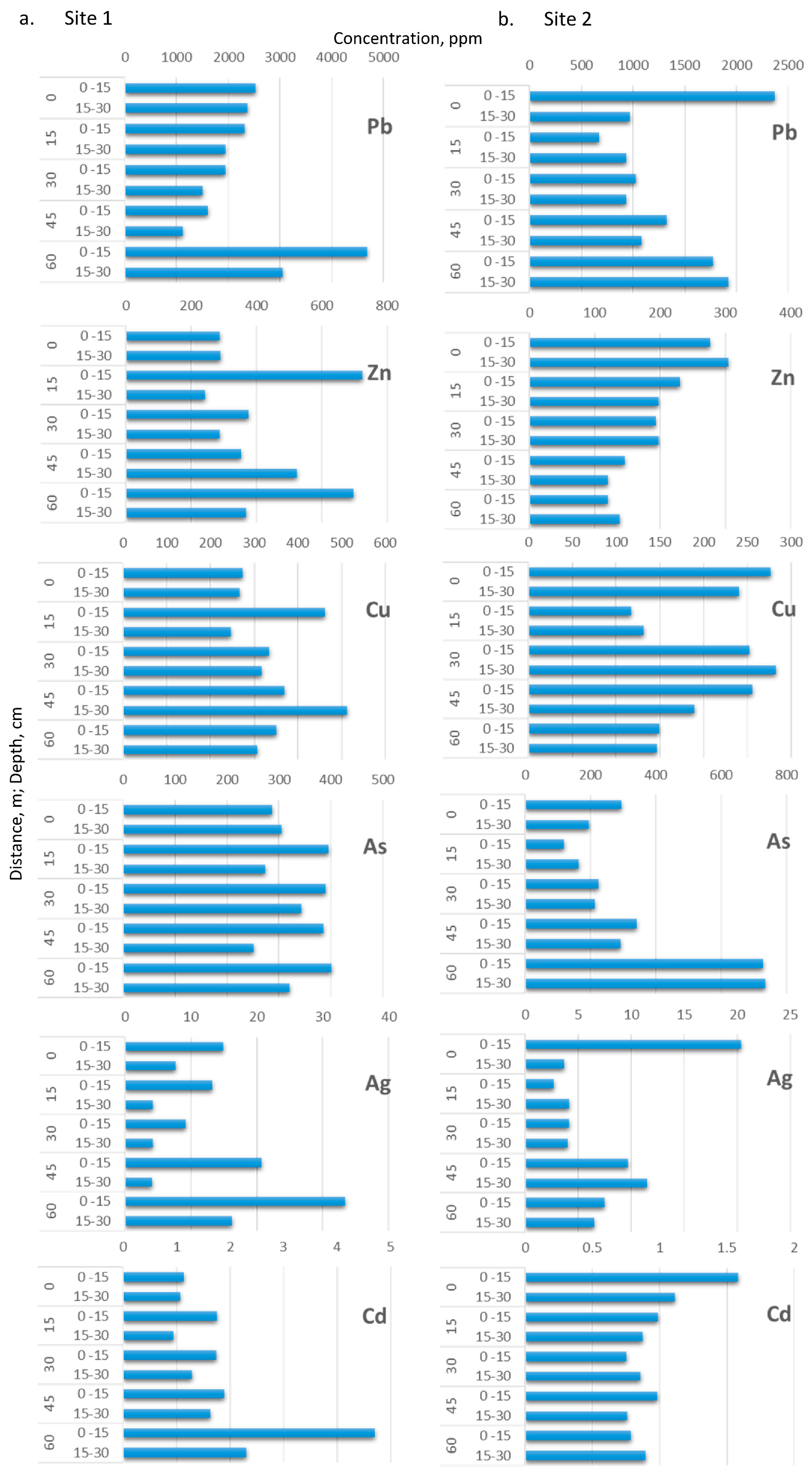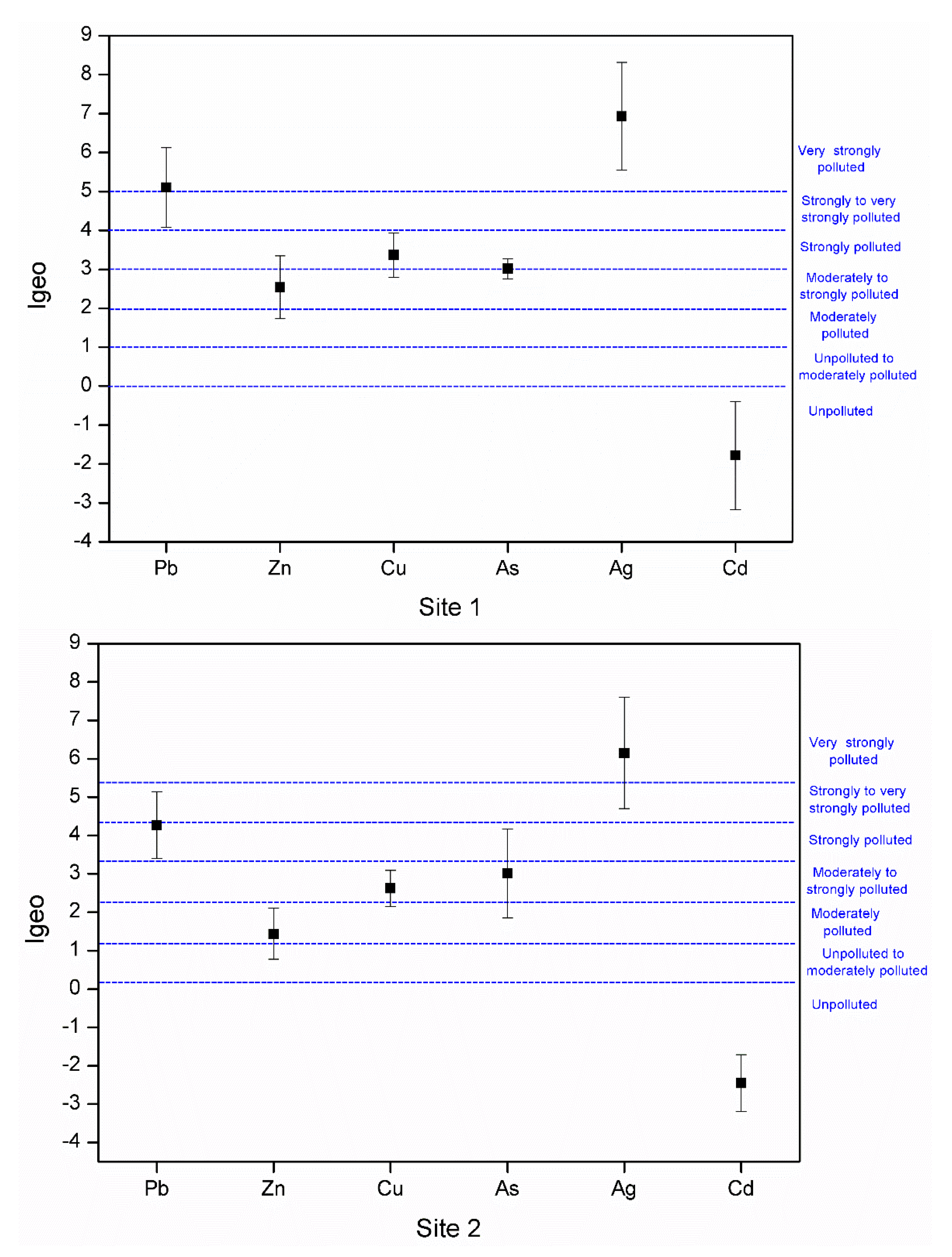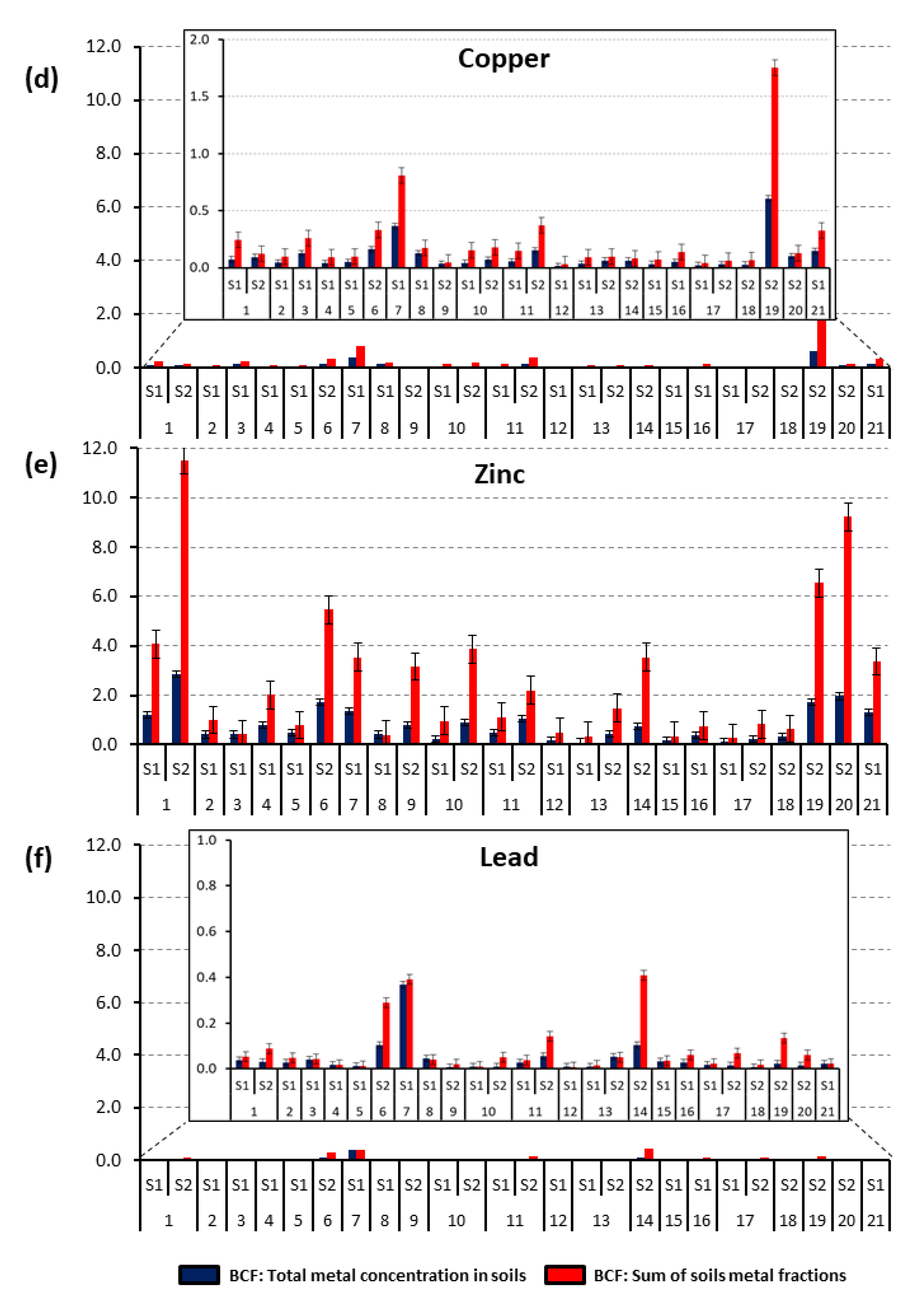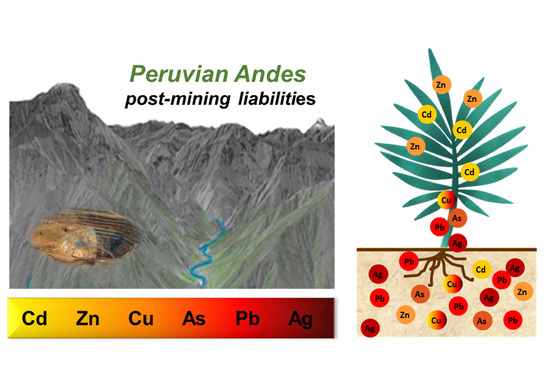Accumulation of As, Ag, Cd, Cu, Pb, and Zn by Native Plants Growing in Soils Contaminated by Mining Environmental Liabilities in the Peruvian Andes
Abstract
:1. Introduction
2. Materials and Methods
2.1. Study Area and Sampling
2.2. Chemical Analysis of Soils
2.3. Calculation of the Geo-Accumulation Index (Igeo)
2.4. Sequential Extraction Procedure
- Exchangeable (loosely bound) metals fraction: 15 mL 1 M CH3COONH4, pH 7 (shaking time 1 h at room temperature) followed by the addition of 30 mL 1 M CH3COONa by acidification with CH3COOH to pH 5 (shaking time 5 h at room temperature).
- Metal bound with hydrated iron and manganese oxides: 30 mL 0.04 M NH2OH·HCl in 25% (v/v) CH3COOH (shaking time 5 h at 95 °C).
- Metals bound with organic matter: 7.5 mL 0.02 M HNO3 + 7.5 mL 30% H2O, pH 2 (shaking time 2 h at 85 °C), then 7.5 mL 30% H2O2, pH 2 was added (shaking time 3 h at 85 °C) and finally, 15 mL 3.2 M CH3COONH4 in 20% (v/v) HNO3 was added (shaking time 0.5 h at room temperature).
- Metals bound to mineral fraction: 4.5 mL 10M HNO3 + 3 × 3 mL H2O2 time 1 h, then 15 mL H2O (shaking time 0.5 h at 95 °C) was added.
2.5. Chemical Analysis of Plants
2.6. Calculation of the Translocation Factor (TF) and the Bioconcentration Factor (BCF)
2.7. Statistics
3. Results and Discussion
3.1. Soil Physicochemical Characterization
3.2. Soil Metal Composition
3.3. Index of Geoaccumulation
3.4. Sequential Extraction Study from the Soil
3.5. Trace Elements in Native Plants
3.6. Bioconcentration (BCF) and Translocation Factor (TF) of the Native Plants
4. Conclusions
Supplementary Materials
Author Contributions
Funding
Institutional Review Board Statement
Informed Consent Statement
Acknowledgments
Conflicts of Interest
References
- Ozturk, M.; Altay, V.; Kucuk, M.; Ertuğrul Yalçın, I. Trace Elements in the Soil-Plant Systems of Copper Mine Areas-A Case Study from Murgul Copper Mine from the Black Sea Region of Turkey. Phyton Int. J. Exp. Bot. 2019, 88, 223–238. [Google Scholar] [CrossRef]
- Paredes, M. The Glocalization of Mining Conflict: Cases from Peru. Extr. Ind. Soc. 2016, 3, 1046–1057. [Google Scholar] [CrossRef]
- Figueroa, B.E.; Orihuela, R.C.; Calfucura, T.E. Green Accounting and Sustainability of the Peruvian Metal Mining Sector. Resour. Policy 2010, 35, 156–167. [Google Scholar] [CrossRef]
- Ministerio de Energía y Minas. Anuario Minero 2018; Oficina de Imagen Institucional y Comunicaciones: Lima, Peru, 2018.
- Lam, E.J.; Cánovas, M.; Gálvez, M.E.; Montofré, Í.L.; Keith, B.F. Evaluation of the Phytoremediation Potential of Native Plants Growing on a Copper Mine Tailing in Northern Chile. J. Geochem. Explor. 2017, 182, 210–217. [Google Scholar] [CrossRef]
- Yildirim, D.; Sasmaz, A. Phytoremediation of As, Ag, and Pb in Contaminated Soils Using Terrestrial Plants Grown on Gumuskoy Mining Area (Kutahya Turkey). J. Geochem. Explor. 2017, 182, 228–234. [Google Scholar] [CrossRef]
- Bouzekri, S.; El Hachimi, M.L.; Touach, N.; El Fadili, H.; El Mahi, M.; Lotfi, E.M. The Study of Metal (As, Cd, Pb, Zn and Cu) Contamination in Superficial Stream Sediments around of Zaida Mine (High Moulouya-Morocco). J. Afr. Earth Sci. 2019, 154, 49–58. [Google Scholar] [CrossRef]
- Aron, A.S.; Molina, O. Green Innovation in Natural Resource Industries: The Case of Local Suppliers in the Peruvian Mining Industry. Extr. Ind. Soc. 2020, 7, 353–365. [Google Scholar] [CrossRef] [Green Version]
- Manjate, E.; Ramos, S.; Almeida, C.M.R. Potential Interferences of Microplastics in the Phytoremediation of Cd and Cu by the Salt Marsh Plant Phragmites Australis. J. Environ. Chem. Eng. 2020, 8, 103658. [Google Scholar] [CrossRef]
- Stefanowicz, A.M.; Kapusta, P.; Zubek, S.; Stanek, M.; Woch, M.W. Soil Organic Matter Prevails over Heavy Metal Pollution and Vegetation as a Factor Shaping Soil Microbial Communities at Historical Zn-Pb Mining Sites. Chemosphere 2020, 240, 124922. [Google Scholar] [CrossRef]
- Ministerio de Energía y Minas Law 28271. Ley Que Regula Los Pasivos Ambientales de La Actividad Minera. In Diario Oficial El Peruano; Editora Peru: Cercado de Lima, Peru, 2004. [Google Scholar]
- Yupari, A. Pasivos Ambientales Mineros En Sudamérica; CEPAL: Santiago, Chile, 2003. [Google Scholar]
- Makhmudova, G.; Matsui, K. The Remediation Policy after Mining Works in the Kyrgyz Republic. Resour. Policy 2019, 61, 304–310. [Google Scholar] [CrossRef]
- Ministerio de Energía y Minas Ministry Resolution N° 010-2019-MEM/DM. Actualizan Inventario Inicial de Pasivos Ambientales Mineros. In Diario Oficial El Peruano; Editora Peru: Cercado de Lima, Peru, 2019. [Google Scholar]
- Chappuis, M. Remediación y Activación de Pasivos Ambientales Mineros (PAM) En El Perú. In Medio Ambiente y Desarrollo N° 168; Comisión Económica para América Latina y el Caribe (CEPAL): Santiago, Chile, 2019. [Google Scholar]
- Pietrobelli, C.; Marin, A.; Olivari, J. Innovation in Mining Value Chains: New Evidence from Latin America. Resour. Policy 2018, 58, 1–10. [Google Scholar] [CrossRef]
- Bian, F.; Zhong, Z.; Zhang, X.; Yang, C.; Gai, X. Bamboo—An Untapped Plant Resource for the Phytoremediation of Heavy Metal Contaminated Soils. Chemosphere 2020, 246, 125750. [Google Scholar] [CrossRef] [PubMed]
- Moreno-Jiménez, E.; Vázquez, S.; Carpena-Ruiz, R.O.; Esteban, E.; Peñalosa, J.M. Using Mediterranean Shrubs for the Phytoremediation of a Soil Impacted by Pyritic Wastes in Southern Spain: A Field Experiment. J. Environ. Manag. 2011, 92, 1584–1590. [Google Scholar] [CrossRef] [PubMed] [Green Version]
- Favas, P.J.C.; Pratas, J.; Varun, M.; Souza, R.D.; Paul, M.S. Phytoremediation of Soils Contaminated with Metals and Metalloids at Mining Areas: Potential of Native Flora. In Environmental Risk Assessment of Soil Contamination; IntechOpen: London, UK, 2014. [Google Scholar]
- Chaabani, S.; Abdelmalek-Babbou, C.; Ben Ahmed, H.; Chaabani, A.; Sebei, A. Phytoremediation Assessment of Native Plants Growing on Pb-Zn Mine Site in Northern Tunisia. Environ. Earth Sci. 2017, 76, 1–15. [Google Scholar] [CrossRef]
- Midhat, L.; Ouazzani, N.; Hejjaj, A.; Ouhammou, A.; Mandi, L. Accumulation of Heavy Metals in Metallophytes from Three Mining Sites (Southern Centre Morocco) and Evaluation of Their Phytoremediation Potential. Ecotoxicol. Environ. Saf. 2019, 169, 150–160. [Google Scholar] [CrossRef]
- Santos-Francés, F.; Martínez-Graña, A.; Rojo, P.A.; Sánchez, A.G. Geochemical Background and Baseline Values Determination and Spatial Distribution of Heavy Metal Pollution in Soils of the Andes Mountain Range (Cajamarca-Huancavelica, Peru). Int. J. Environ. Res. Public Health 2017, 14, 859. [Google Scholar] [CrossRef] [Green Version]
- Canchaya, S. Stratabound ore deposits of Hualgayoc, Cajamarca, Perú. In Stratabound Ore Deposits in the Andes; Fontboté, L., Amstutz, C., Cardozo, M., Cedillo, E., Frutos, J., Eds.; Springer: Berlin/Heidelberg, Germany, 1990; pp. 569–582. ISBN 9783642882845. [Google Scholar]
- Macfarlane, A.W.; Prol-Ledesma, R.M.; Conrad, M.E. Isotope and Fluid Inclusion Studies of Geological and Hydrothermal Processes, Northern Peru. Int. Geol. Rev. 1994, 36, 645–677. [Google Scholar] [CrossRef]
- Padilla, W.G. Hualgayoc, Riqueza y Tradición; Asociación Cultural ArteSano: Cajamarca, Peru, 2019; ISBN 978-612-47933-0-1. [Google Scholar]
- Macfarlane, A.W.; Petersen, U. Pb Isotopes of the Hualgayoc Area, Northern Peru: Implications for Metal Provenance and Genesis of a Cordilleran Polymetallic Mining District. Econ. Geol. 1990, 85, 1303–1327. [Google Scholar] [CrossRef]
- Bech, J.; Poschenrieder, C.; Barceló, J.; Lansac, A. Plants from Mine Spoils in the South American Area as Potential Sources of Germplasm for Phytorenmediation Technologies. Acta Biotechnol. 2002, 22, 5–11. [Google Scholar] [CrossRef]
- Walkley, A.; Black, I.A. Estimation of Soil Organic Carbon by the Chromic Acid Titration Method. Soil Sci. 1934, 37, 29–38. [Google Scholar] [CrossRef]
- Bouyoucos, G.J. Directions for Making Mechanical Analyses of Soils by the Hydrometer Method. Soil Sci. 1936, 42, 225–229. [Google Scholar] [CrossRef]
- Muller, G. Index of Geo-Accumulation in Sediments of the Rhine River. Geojournal 1969, 2, 108–118. [Google Scholar]
- Yaroshevsky, A.A. Abundances of Chemical Elements in the Earth’s Crust. Geochem. Int. 2006, 44, 48–55. [Google Scholar] [CrossRef]
- Okedeyi, O.O.; Dube, S.; Awofolu, O.R.; Nindi, M.M. Assessing the Enrichment of Heavy Metals in Surface Soil and Plant (Digitaria Eriantha) around Coal-Fired Power Plants in South Africa. Environ. Sci. Pollut. Res. 2014, 21, 4686–4696. [Google Scholar] [CrossRef] [PubMed]
- Tessier, A.; Campbell, P.G.C.; Bisson, M. Sequential Extraction Procedure for the Speciation of Particulate Trace Metals. Anal. Chem. 1979, 51, 844–851. [Google Scholar] [CrossRef]
- Głosińska, G.; Sobczyński, T.; Boszke, L.; Bierła, K.; Siepak, J. Fractionation of Some Heavy Metals in Bottom Sediments from the Middle Odra River (Germany/Poland). Pol. J. Environ. Stud. 2005, 14, 305–317. [Google Scholar]
- Lago-Vila, M.; Arenas-Lago, D.; Rodríguez-Seijo, A.; Andrade, M.L.; Vega, F.A. Ability of Cytisus Scoparius for Phytoremediation of Soils from a Pb/Zn Mine: Assessment of Metal Bioavailability and Bioaccumulation. J. Environ. Manag. 2019, 235, 152–160. [Google Scholar] [CrossRef]
- Kamari, A.; Yusoff, S.N.M.; Putra, W.P.; Ishak, C.F.; Hashim, N.; Mohamed, A.; Phillip, E. Metal Uptake in Water Spinach Grown on Contaminated Soil Amended with Chicken Manure and Coconut Tree Sawdust. Environ. Eng. Manag. J. 2014, 13, 2219–2228. [Google Scholar] [CrossRef]
- Yoon, J.; Cao, X.; Zhou, Q.; Ma, L.Q. Accumulation of Pb, Cu, and Zn in Native Plants Growing on a Contaminated Florida Site. Sci. Total Environ. 2006, 368, 456–464. [Google Scholar] [CrossRef]
- Ghazaryan, K.; Movsesyan, H.; Ghazaryan, N.; Watts, B.A. Copper Phytoremediation Potential of Wild Plant Species Growing in the Mine Polluted Areas of Armenia. Environ. Pollut. 2019, 249, 491–501. [Google Scholar] [CrossRef]
- Cruzado-Tafur, E.; Torró, L.; Bierla, K.; Szpunar, J.; Tauler, E. Heavy Metal Contents in Soils and Native Flora Inventory at Mining Environmental Liabilities in the Peruvian Andes. J. S. Am. Earth Sci. 2021, 106, 1–12. [Google Scholar] [CrossRef]
- Kabata-Pendias, A. Trace Elements in Soils and Plants, 4th ed.; CRC Press: Boca Raton, FL, USA, 2011; Volume 53, ISBN 9781420093681. [Google Scholar]
- Tuo, D.; Xu, M.; Zhao, Y.; Gao, L. Interactions between Wind and Water Erosion Change Sediment Yield and Particle Distribution under Simulated Conditions. J. Arid Land 2015, 7, 590–598. [Google Scholar] [CrossRef]
- Egerić, M.; Smičiklas, I.; Dojčinović, B.; Sikirić, B.; Jović, M. Geoderma Interactions of Acidic Soil near Copper Mining and Smelting Complex and Waste-Derived Alkaline Additives. Geoderma 2019, 352, 241–250. [Google Scholar] [CrossRef]
- Bech, J.; Roca, N.; Tume, P.; Ramos-Miras, J.; Gil, C.; Boluda, R. Screening for New Accumulator Plants in Potential Hazards Elements Polluted Soil Surrounding Peruvian Mine Tailings. Catena 2016, 136, 66–73. [Google Scholar] [CrossRef]
- Ministerio del Ambiente Supreme Decree N° 011-2017-MINAM. Aprueban Estándares de Calidad Ambiental (ECA) Para Suelo. In Diario Oficial El Peruano; Editora Peru: Cercado de Lima, Peru, 2017. [Google Scholar]
- Canadian Council of Ministers of the Environment. Canadian Soil Quality Guidelines for the Protection of Environmental and Human Health: Summary Tables; Canadian Council of Ministers of the Environment: Winnineg, MB, Canada, 2007. [Google Scholar]
- Canadian Council of Ministers of the Environment. Canadian Soil Quality Guidelines for the Protection of Environmental and Human Health: Zinc 2018; Canadian Council of Ministers of the Environment: Winnineg, MB, Canada, 2018. [Google Scholar]
- Bech, J.; Roca, N.; Tume, P. Hazardous Element Accumulation in Soils and Native Plants in Areas Affected by Mining Activities in South America. In Assessment, Restoration and Reclamation of Mining Influenced Soils; Elsevier Inc.: Amsterdam, The Netherlands, 2017; pp. 419–461. ISBN 9780128095881. [Google Scholar]
- Perlatti, F.; Osório Ferreira, T.; Espíndola Romero, R.; Gomes Costa, M.C.; Otero, X.L. Copper Accumulation and Changes in Soil Physical-Chemical Properties Promoted by Native Plants in an Abandoned Mine Site in Northeastern Brazil: Implications for Restoration of Mine Sites. Ecol. Eng. 2015, 82, 103–111. [Google Scholar] [CrossRef]
- Acosta, J.A.; Arocena, J.M.; Faz, A. Chemosphere Speciation of Arsenic in Bulk and Rhizosphere Soils from Artisanal Cooperative Mines in Bolivia. Chemosphere 2015, 138, 1014–1020. [Google Scholar] [CrossRef] [PubMed]
- Santos-Jallath, J.; Castro-Rodríguez, A.; Huezo-Casillas, J.; Torres-Bustillos, L. Arsenic and Heavy Metals in Native Plants at Tailings Impoundments in Queretaro, Mexico. Phys. Chem. Earth 2012, 37, 10–17. [Google Scholar] [CrossRef]
- Herrera-Quiterio, A.; Toledo-Hernández, E.; Aguirre-Noyola, J.L.; Romero, Y.; Ramos, J.; Palemón-Alberto, F.; Toribio-Jiménez, J. Antagonic and Plant Growth-Promoting Effects of Bacteria Isolated from Mine Tailings at El Fraile, Mexico. Revista Argentina de Microbiología 2020, 52, 231–239. [Google Scholar] [CrossRef]
- Yang, S.X.; Liao, B.; Yang, Z.H.; Chai, L.Y.; Li, J.T. Revegetation of Extremely Acid Mine Soils Based on Aided Phytostabilization: A Case Study from Southern China. Sci. Total Environ. 2016, 562, 427–434. [Google Scholar] [CrossRef]
- Arenas-Lago, D.; Andrade, M.L.; Lago-Vila, M.; Rodríguez-Seijo, A.; Vega, F.A. Sequential Extraction of Heavy Metals in Soils from a Copper Mine: Distribution in Geochemical Fractions. Geoderma 2014, 230, 108–118. [Google Scholar] [CrossRef]
- He, Z.L.; Yang, X.E.; Stoffella, P.J. Trace Elements in Agroecosystems and Impacts on the Environment. J. Trace Elem. Med. Biol. 2005, 19, 125–140. [Google Scholar] [CrossRef] [PubMed]
- Ha, N.T.H.; Ha, N.T.; Nga, T.T.H.; Minh, N.N.; Anh, B.T.K.; Hang, N.T.A.; Duc, N.A.; Nhuan, M.T.; Kim, K.W. Applied Geochemistry Uptake of Arsenic and Heavy Metals by Native Plants Growing near Nui Phao Multi-Metal Mine, Northern Vietnam. Appl. Geochem. 2019, 108, 104368. [Google Scholar] [CrossRef]
- França Afonso, T.; Faccio Demarco, C.; Pieniz, S.; Silveira Quadro, M.; Camargo, F.A.; Andreazza, R. Bioprospection of Indigenous Flora Grown in Copper Mining Tailing Area for Phytoremediation of Metals. J. Environ. Manag. 2020, 256, 109953. [Google Scholar] [CrossRef] [PubMed]
- Claveria, R.J.R.; Perez, T.R.; Perez, R.E.C.; Algo, J.L.C.; Robles, P.Q. The Identification of Indigenous Cu and As Metallophytes in the Lepanto Cu-Au Mine, Luzon, Philippines. Environ. Monit. Assess. 2019, 191, 185. [Google Scholar] [CrossRef]
- Huang, R.; Dong, M.; Mao, P.; Zhuang, P.; Paz-Ferreiro, J.; Li, Y.; Li, Y.; Hu, X.; Netherway, P.; Li, Z. Evaluation of Phytoremediation Potential of Five Cd (Hyper)Accumulators in Two Cd Contaminated Soils. Sci. Total Environ. 2020, 51, 137581. [Google Scholar] [CrossRef]
- Fernández, S.; Poschenrieder, C.; Marcenò, C.; Gallego, J.R.; Jiménez-Gámez, D.; Bueno, A.; Afif, E. Phytoremediation Capability of Native Plant Species Living on Pb-Zn and Hg-As Mining Wastes in the Cantabrian Range, North of Spain. J. Geochem. Explor. 2017, 174, 10–20. [Google Scholar] [CrossRef]
- Cui, J.; Zhao, Y.; Chan, T.; Zhang, L.; Tsang, D.C.W.; Li, X. Spatial Distribution and Molecular Speciation of Copper in Indigenous Plants from Contaminated Mine Sites: Implication for Phytostabilization. J. Hazard. Mater. 2020, 381, 121208. [Google Scholar] [CrossRef]
- Hosseini, S.M.; Rezazadeh, M.; Salimi, A.; Ghorbanli, M. Distribution of Heavy Metals and Arsenic in Soils and Indigenous Plants near an Iron Ore Mine in Northwest Iran. Acta Ecol. Sin. 2018, 38, 363–367. [Google Scholar] [CrossRef]
- Vidal Ccana-Ccapatinta, G.; Lino von Poser, G. Phytochemistry Letters Acylphloroglucinol Derivatives from Hypericum Laricifolium Juss. Phytochem. Lett. 2015, 12, 63–68. [Google Scholar] [CrossRef]
- Drozdova, I.; Alekseeva-Popova, N.; Dorofeyev, V.; Bech, J.; Belyaeva, A.; Roca, N. A Comparative Study of the Accumulation of Trace Elements in Brassicaceae Plant Species with Phytoremediation Potential. Appl. Geochem. 2019, 108, 104377. [Google Scholar] [CrossRef]
- Chandra, R.; Kumar, V.; Tripathi, S.; Sharma, P. Heavy Metal Phytoextraction Potential of Native Weeds and Grasses from Endocrine-Disrupting Chemicals Rich Complex Distillery Sludge and Their Histological Observations during in-Situ Phytoremediation. Ecol. Eng. 2018, 111, 143–156. [Google Scholar] [CrossRef]
- Bech, J.; Duran, P.; Roca, N.; Poma, W.; Sánchez, I.; Barceló, J.; Boluda, R.; Roca-Pérez, L.; Poschenrieder, C. Shoot Accumulation of Several Trace Elements in Native Plant Species from Contaminated Soils in the Peruvian Andes. J. Geochem. Explor. 2012, 113, 106–111. [Google Scholar] [CrossRef]
- Pedron, F.; Petruzzelli, G.; Barbafieri, M.; Tassi, E. Strategies to Use Phytoextraction in Very Acidic Soil Contaminated by Heavy Metals. Chemosphere 2009, 75, 808–814. [Google Scholar] [CrossRef] [PubMed]
- Nagy, A.; Magyar, T.; Juhász, C.; Tamás, J. Phytoremediation of Acid Mine Drainage Using By-Product of Lysine Fermentation. Water Sci. Technol. 2020, 1507–1517. [Google Scholar] [CrossRef]
- Xiao, R.; Shen, F.; Du, J.; Li, R.; Lahori, A.H.; Zhang, Z. Screening of Native Plants from Wasteland Surrounding a Zn Smelter in Feng County China, for Phytoremediation. Ecotoxicol. Environ. Saf. 2018, 162, 178–183. [Google Scholar] [CrossRef]







| Distance (m) | Depth (cm) | pH | EC (dS m−1) | Carbonates (%) | Organic Matter (%) | Soil Texture (%) | ||
|---|---|---|---|---|---|---|---|---|
| R: <5.5–>8.8 | R: <2–>8 | Sand | Silt | Clay | ||||
| Sampling area #1 | ||||||||
| 0 | 0–15 | 4.02 | 0.08 | 0 | 7.6 | 66 | 22 | 12 |
| 15–30 | 3.97 | 0.09 | 0 | 4.3 | 50 | 24 | 26 | |
| 15 | 0–15 | 4.19 | 0.05 | 0 | 4.4 | 52 | 26 | 22 |
| 15–30 | 3.89 | 0.07 | 0 | 2.5 | 42 | 22 | 36 | |
| 30 | 0–15 | 3.63 | 0.13 | 0 | 3.5 | 52 | 24 | 24 |
| 15–30 | 3.84 | 0.15 | 0 | 3.8 | 54 | 28 | 18 | |
| 45 | 0–15 | 3.63 | 0.08 | 0 | 5.7 | 66 | 18 | 16 |
| 15–30 | 3.67 | 0.08 | 0 | 1.8 | 52 | 22 | 26 | |
| 60 | 0–15 | 3.76 | 0.05 | 0 | 4.2 | 54 | 28 | 18 |
| 15–30 | 3.59 | 0.09 | 0 | 4.5 | 50 | 24 | 26 | |
| Sampling area #2 | ||||||||
| 0 | 0–15 | 3.42 | 0.08 | 0 | 10.6 | 60 | 22 | 18 |
| 15–30 | 3.37 | 0.11 | 0 | 5.0 | 56 | 24 | 20 | |
| 15 | 0–15 | 4.02 | 0.02 | 0 | 4.4 | 54 | 20 | 26 |
| 15–30 | 3.89 | 0.02 | 0 | 4.4 | 62 | 20 | 18 | |
| 30 | 0–15 | 3.37 | 0.14 | 0 | 2.5 | 52 | 18 | 30 |
| 15–30 | 3.46 | 0.14 | 0 | 2.9 | 54 | 18 | 28 | |
| 45 | 0–15 | 3.85 | 0.05 | 0 | 4.9 | 56 | 22 | 22 |
| 15–30 | 3.72 | 0.05 | 0 | 3.3 | 58 | 22 | 20 | |
| 60 | 0–15 | 2.94 | 0.32 | 0 | 2.2 | 54 | 24 | 22 |
| 15–30 | 2.77 | 0.57 | 0 | 1.7 | 54 | 20 | 26 | |
| Pb. | Zn | Cu | As | Ag | Cd | pH | pH Values | Name of the Mine | Status of the Mine | Country | Reference |
|---|---|---|---|---|---|---|---|---|---|---|---|
| 3992–16,060 | 11,550–28,059 | 256–2070 | 280–1030 | - | - | acid basic | 6.8–8 | Caroline mine-Hualgayoc | not active | Peru | [47] |
| 87–341 | 56–772 | 69–5270 | 143–7670 | - | 8.9–499 | acid | 4.8 | Turmaline mine-Piura | abandoned | ||
| 5.1–39.8 | 42–96 | 264- 977 | - | - | - | acid | 3.9 | El teniente mine | active | Chile | |
| 59–4890 | 58–18610 | 3–189 | 8.4–2240 | 1.6–178 | 2.9–342 | acid | <4 | San Bartolomé mine | abandoned | Ecuador | |
| - | - | 1180–6310 | - | - | - | acid | 5.1–6.2 | Petra verde mine | abandoned | Brazil | [48] |
| - | - | - | 36–64 | - | - | acid | 4.5–5 | Virgen Del Rosario and the Rayo Rojo cooperative mines | active artisanal | Bolivia | [49] |
| 327–1754 | 448–505 | 149–459 | 183–14,660 | - | 45–308 | acid basic | 2.1–8.3 | La Negra mine | abandoned | Mexico | [50] |
| 780–43,700 | 380–>10,000 | 71.8–1320 | 19–11,800 | 9.5–74.2 | 1.0–780 | acid | 2.3–2.9 | El Fraile mine | active | Mexico | [51] |
| 670–4683 | 120–724 | 117–512 | 119–736 | 2.7–20.7 | 0.7–4.7 | acid | 2.8–4.9 | Hualgayoc | abandoned | Peru | This work |
Publisher’s Note: MDPI stays neutral with regard to jurisdictional claims in published maps and institutional affiliations. |
© 2021 by the authors. Licensee MDPI, Basel, Switzerland. This article is an open access article distributed under the terms and conditions of the Creative Commons Attribution (CC BY) license (http://creativecommons.org/licenses/by/4.0/).
Share and Cite
Cruzado-Tafur, E.; Bierla, K.; Torró, L.; Szpunar, J. Accumulation of As, Ag, Cd, Cu, Pb, and Zn by Native Plants Growing in Soils Contaminated by Mining Environmental Liabilities in the Peruvian Andes. Plants 2021, 10, 241. https://doi.org/10.3390/plants10020241
Cruzado-Tafur E, Bierla K, Torró L, Szpunar J. Accumulation of As, Ag, Cd, Cu, Pb, and Zn by Native Plants Growing in Soils Contaminated by Mining Environmental Liabilities in the Peruvian Andes. Plants. 2021; 10(2):241. https://doi.org/10.3390/plants10020241
Chicago/Turabian StyleCruzado-Tafur, Edith, Katarzyna Bierla, Lisard Torró, and Joanna Szpunar. 2021. "Accumulation of As, Ag, Cd, Cu, Pb, and Zn by Native Plants Growing in Soils Contaminated by Mining Environmental Liabilities in the Peruvian Andes" Plants 10, no. 2: 241. https://doi.org/10.3390/plants10020241








